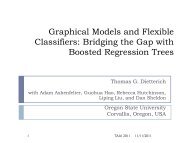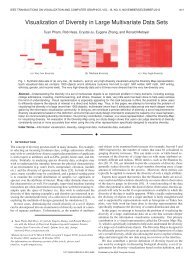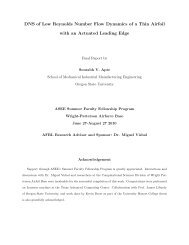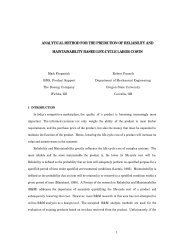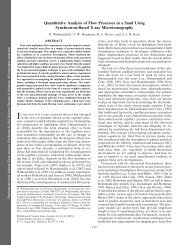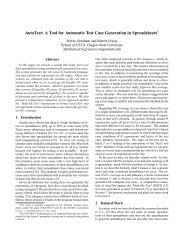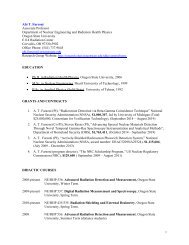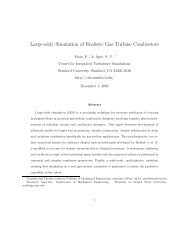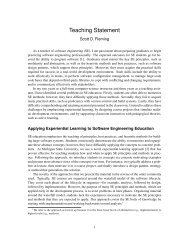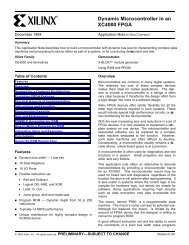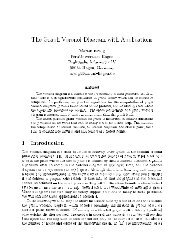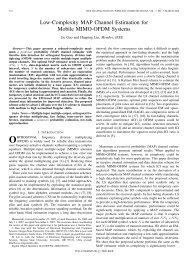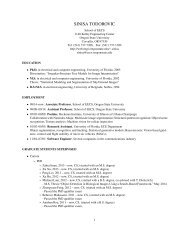ILASS Americas 20th Annual Conference on Liquid Atomization and ...
ILASS Americas 20th Annual Conference on Liquid Atomization and ...
ILASS Americas 20th Annual Conference on Liquid Atomization and ...
You also want an ePaper? Increase the reach of your titles
YUMPU automatically turns print PDFs into web optimized ePapers that Google loves.
<str<strong>on</strong>g>ILASS</str<strong>on</strong>g> <str<strong>on</strong>g>Americas</str<strong>on</strong>g> <str<strong>on</strong>g>20th</str<strong>on</strong>g> <str<strong>on</strong>g>Annual</str<strong>on</strong>g> <str<strong>on</strong>g>C<strong>on</strong>ference</str<strong>on</strong>g> <strong>on</strong> <strong>Liquid</strong> Atomizati<strong>on</strong> <strong>and</strong> Spray Systems, Chicago, IL, May 2007<br />
Modeling Volumetric Coupling of the Dispersed Phase using the<br />
Eulerian-Lagrangian Approach<br />
Ehsan Shams ∗ <strong>and</strong> Sourabh V. Apte<br />
School of Mechanical, Manufacturing <strong>and</strong> Industrial Engineering<br />
Oreg<strong>on</strong> State University<br />
204 Rogers Hall, Corvallis, OR 97331<br />
Abstract<br />
The Eulerian-Lagrangian approach is comm<strong>on</strong>ly used in modeling two-phase flows wherein liquid droplets,<br />
solid particles, or bubbles are dispersed in a c<strong>on</strong>tinuum fluid of a different phase. Typically, the moti<strong>on</strong> of the<br />
dispersed phase is modeled by assuming spherical, point-particles with models for added mass effects, drag,<br />
<strong>and</strong> lift forces. The effect of the dispersed phase <strong>on</strong> the fluid flow is modeled using reacti<strong>on</strong> forces in the fluid<br />
momentum equati<strong>on</strong>. Such an approach is valid for dilute regi<strong>on</strong>s of the dispersed phase. For dense regi<strong>on</strong>s,<br />
however, the point-particle approach does not capture the interacti<strong>on</strong>s between the fluid <strong>and</strong> the dispersed<br />
phase accurately. In this work, the fluid volume displaced by the dispersed phase is taken into account to<br />
model the dense regi<strong>on</strong>s. The moti<strong>on</strong> of the dispersed phase results in local, spatio-temporal variati<strong>on</strong>s of the<br />
volume fracti<strong>on</strong> fields. The resultant divergence in the fluid velocity acts as a source or sink displacing the<br />
flow due to dispersed phase <strong>and</strong> is termed as volumetric coupling. The size of the dispersed phase is assumed<br />
smaller than the grid resoluti<strong>on</strong> <strong>and</strong> for the c<strong>on</strong>tinuum phase. The variable–density, low–Mach number<br />
equati<strong>on</strong>s based <strong>on</strong> mixture theory are solved using a co–located, finite volume scheme. The interphase<br />
momentum exchange due to drag forces is treated implicitly to provide robustness in the dense regi<strong>on</strong>s.<br />
The volumetric coupling approach is first validated with analytical studies for flow induced by oscillating<br />
bubbles <strong>and</strong> gravitati<strong>on</strong>al settling of particles. Simulati<strong>on</strong>s of Rayleigh-Taylor instability, particle-laden jet<br />
impingement <strong>on</strong> a flat plate, <strong>and</strong> particle-laden jet in a cross are performed to test the robustness of the<br />
scheme.<br />
∗ Corresp<strong>on</strong>ding Author: shamssoe@engr.orst.edu
Introducti<strong>on</strong><br />
Majority of spray systems in propulsi<strong>on</strong> applicati<strong>on</strong>s<br />
involve complex geometries <strong>and</strong> highly<br />
unsteady, turbulent flows near the injector. The<br />
numerical models for spray calculati<strong>on</strong>s should be<br />
able to accurately represent droplet deformati<strong>on</strong>,<br />
breakup, collisi<strong>on</strong>/coalescence, <strong>and</strong> dispersi<strong>on</strong> due<br />
to turbulence. In the traditi<strong>on</strong>al approach for spray<br />
computati<strong>on</strong>, the Eulerian equati<strong>on</strong>s for gaseous<br />
phase are solved al<strong>on</strong>g with a Lagrangian model for<br />
particle transport with two-way coupling of mass,<br />
momentum, <strong>and</strong> energy exchange between the two<br />
phases [1]. Typically simulati<strong>on</strong>s of spray systems<br />
use DNS, LES or RANS for the carrier phase<br />
whereas the moti<strong>on</strong> of the dispersed phase is modeled.<br />
The ‘point-particle’ (PP) assumpti<strong>on</strong> is comm<strong>on</strong>ly<br />
employed where forces <strong>on</strong> the dispersed phase<br />
are computed through model coefficients. The effect<br />
of the particles 1 <strong>on</strong> the carrier phase is represented<br />
by a force applied at the centroid of the particle.<br />
The disperse phase equati<strong>on</strong>s are typically solved in<br />
a Lagrangian frame by tracking a few set of computati<strong>on</strong>al<br />
particles or parcels [2] with models for<br />
droplet breakup, collisi<strong>on</strong>/coalescence, evaporati<strong>on</strong>,<br />
dispersi<strong>on</strong>, <strong>and</strong> deformati<strong>on</strong>. Fully resolved simulati<strong>on</strong>s<br />
involving comprehensive modeling of interfacial<br />
dynamics are being developed [3, 4], however,<br />
are computati<strong>on</strong>ally expensive.<br />
Several simulati<strong>on</strong>s of particle-laden flows have<br />
been performed with the carrier fluid simulated using<br />
direct numerical simulati<strong>on</strong> ([5, 6],[7],[8]), largeeddy<br />
simulati<strong>on</strong> ([9, 10, 11, 12]), or Reynoldsaveraged<br />
Navier Stokes equati<strong>on</strong>s [13], where the dispersed<br />
phase is assumed subgrid (so d p < L K , the<br />
Kolmogorov length scale, for DNS whereas d p < ∆,<br />
the grid size, in LES or RANS). However, modeling<br />
the dispersed phase using point-particle approach<br />
does not always provide the correct results. For<br />
moderate loadings <strong>and</strong> wall-bounded flows [11] have<br />
shown that the point-particle approximati<strong>on</strong> fails to<br />
predict the turbulence modulati<strong>on</strong> compared to experimental<br />
values. In additi<strong>on</strong>, if the particle size<br />
is comparable to the Kolmogorov scale (for DNS)<br />
or the grid size (for LES/RANS), simple drag/lift<br />
laws typically employed in PP do not capture the<br />
unsteady wake effects comm<strong>on</strong>ly observed in full<br />
DNS studies ([14, 15]). These effects become even<br />
more pr<strong>on</strong>ounced in dense particulate regi<strong>on</strong>s. In<br />
many practical applicati<strong>on</strong>s, the local particle size<br />
<strong>and</strong> c<strong>on</strong>centrati<strong>on</strong>s may vary substantially. In liquid<br />
atomizati<strong>on</strong> process, e.g., the droplet sizes may<br />
range from 1 mm to 1 µm with dense regi<strong>on</strong>s near<br />
the injector nozzle. The point-particle assumpti<strong>on</strong><br />
is invalid under these c<strong>on</strong>diti<strong>on</strong>s.<br />
In the present work, we extend the point-particle<br />
approach by accounting for the volumetric displacements<br />
of the carried phase due to the moti<strong>on</strong> of particles<br />
or droplets. The disperse phase also affects the<br />
carrier phase through mass, momentum, <strong>and</strong> energy<br />
coupling. The combined effect is termed as ‘volumetric<br />
coupling’. This approach is based <strong>on</strong> the the<br />
original formulati<strong>on</strong> by Duckowicz [1] <strong>and</strong> later modified<br />
by Joseph & Lundgren [16]. The approach is<br />
derived based <strong>on</strong> mixture theory that account for<br />
the droplet (or particle) volume fracti<strong>on</strong> in a given<br />
computati<strong>on</strong>al cell. This effect is important in dense<br />
spray regimes, however, are typically ignored in the<br />
c<strong>on</strong>text of LES or DNS simulati<strong>on</strong>s [17, 12]. A similar<br />
formulati<strong>on</strong> has been applied to bubbly flows at<br />
low bubble c<strong>on</strong>centrati<strong>on</strong>s (up to 0.02) to investigate<br />
the effect of bubbles <strong>on</strong> drag reducti<strong>on</strong> in turbulent<br />
flows [8, 18]. Several studies <strong>on</strong> laminar dense granular<br />
flows [19, 20, 21] also use this approach. Recently,<br />
Apte etal. [22] have shown the effect of volumetric<br />
displacements <strong>on</strong> the carrier fluid in dense<br />
particle-laden flows. They compared the soluti<strong>on</strong>s<br />
for the carrier phase <strong>and</strong> the particle dispersi<strong>on</strong> obtained<br />
from the point-particle assumpti<strong>on</strong> <strong>and</strong> accounting<br />
for volumetric displacements to show large<br />
differences. If the volume displaced by the disperse<br />
phase is taken into account, thte velocity field is no<br />
l<strong>on</strong>ger divergence free in the regi<strong>on</strong>s of variati<strong>on</strong>s<br />
in volume fracti<strong>on</strong>s. This has a direct effect <strong>on</strong> the<br />
pressure Poiss<strong>on</strong> equati<strong>on</strong>, altering the pressure field<br />
through a local source term. These effects may become<br />
important in dense regi<strong>on</strong>s of spray system.<br />
However, computing dense spray systems by accounting<br />
for volume displacements due to droplet<br />
moti<strong>on</strong> could be numerically challenging. The temporal<br />
<strong>and</strong> spatial variati<strong>on</strong>s in fluid volume fracti<strong>on</strong>s<br />
could be locally large <strong>and</strong> make the computati<strong>on</strong> numerically<br />
unstable. This is specifically true if the interphase<br />
coupling of mass, momentum, <strong>and</strong> energy<br />
is treated explicitly. In the present work, we focus<br />
<strong>on</strong> n<strong>on</strong>-reacting flows <strong>and</strong> <strong>on</strong>ly momentum exchange<br />
between the two-phases is c<strong>on</strong>sidered. A numerical<br />
approach based <strong>on</strong> co-located grid finite-volume<br />
method is developed with part of the momentum<br />
exchange terms treated implicitly. The approach is<br />
similar to the fracti<strong>on</strong>al step algorithms for particlein<br />
cell methods <strong>on</strong> staggered grids [19, 21, 20]. Implementati<strong>on</strong><br />
in co-located finite-volume formulati<strong>on</strong><br />
is discussed <strong>and</strong> is applicable to unstructured grids.<br />
1 In this paper, particle may mean solid particle, liquid<br />
droplets, or bubbles depending up<strong>on</strong> the case being studied.
Governing Equati<strong>on</strong>s<br />
The formulati<strong>on</strong> described below c<strong>on</strong>sists of the<br />
Eulerian fluid <strong>and</strong> Lagrangian particle equati<strong>on</strong>s,<br />
<strong>and</strong> accounts for the displacement of the fluid by the<br />
particles as well as the momentum exchange between<br />
them ([16]). An Eulerian-Lagrangian framework is<br />
used to solve the coupled two-phase flow equati<strong>on</strong>s.<br />
The disperse phase equati<strong>on</strong>s are solved in a Lagrangian<br />
frame with models for for drag, buoyancy,<br />
<strong>and</strong> inter-particle collisi<strong>on</strong> forces.<br />
C<strong>on</strong>tinuum-phase equati<strong>on</strong>s<br />
In the present formulati<strong>on</strong>, both c<strong>on</strong>tinuity <strong>and</strong><br />
momentum equati<strong>on</strong>s account for the local c<strong>on</strong>centrati<strong>on</strong><br />
of particles in the c<strong>on</strong>tinuum phase. The<br />
fluid mass for unit volume satisfies a c<strong>on</strong>tinuity equati<strong>on</strong>,<br />
∂<br />
∂t (ρ f Θ f ) + ▽ · (ρ f Θ f u f ) = 0 (1)<br />
where ρ f , Θ f , <strong>and</strong> u f are density, c<strong>on</strong>centrati<strong>on</strong>,<br />
<strong>and</strong> velocity of the fluid phase respectively. Local<br />
spatio-temporal variati<strong>on</strong>s of particle c<strong>on</strong>centrati<strong>on</strong>,<br />
generate a n<strong>on</strong>-divergence free velocity field in the<br />
flow. The n<strong>on</strong>-zero velocity divergence can be shown<br />
by rearranging the equati<strong>on</strong> 1.<br />
∇ · u f = − 1 DΘ f<br />
Θ f Dt<br />
(2)<br />
where D Dt<br />
is the material derivative with respect to<br />
fluid velocity.<br />
Fluid c<strong>on</strong>centrati<strong>on</strong> is calculated as Θ f = 1−Θ p ,<br />
where Θ p is particle c<strong>on</strong>centrati<strong>on</strong>. Lagrangian<br />
quantities, such as particle c<strong>on</strong>centrati<strong>on</strong>, are interpolated<br />
to the Eulerian c<strong>on</strong>trol volumes effectively,<br />
using the following interpolati<strong>on</strong> functi<strong>on</strong>,<br />
N p<br />
∑<br />
Θ p (x cv ) = V p G ∆ (x cv , x p ) (3)<br />
p=1<br />
where x cv <strong>and</strong> x p are c<strong>on</strong>trol volume <strong>and</strong> particle<br />
positi<strong>on</strong>s, respectively, V p is the particle volume, G ∆<br />
is the interpolati<strong>on</strong> functi<strong>on</strong>, N p is the total number<br />
of particles, <strong>and</strong> the summati<strong>on</strong> is over all particles.<br />
Momentum c<strong>on</strong>servati<strong>on</strong> is also satisfied by solving<br />
∂<br />
∂t (ρ f Θ f u f ) + ∇ · (ρ f Θ f u f u f ) =<br />
−∇ (Θ f p) + ∇ · (µ f D c ) + F (4)<br />
where p is dynamic pressure, µ f is the fluid viscosity,<br />
D c = ∇u c + ∇u T c is the deformati<strong>on</strong> tensor of<br />
the mixture, u c = Θ f u f + Θ p u s is the composite<br />
velocity of mixture, <strong>and</strong> F is the reacti<strong>on</strong> force from<br />
the particle phase <strong>on</strong> the fluid phase per unit mass<br />
of fluid. Average particle velocity in c<strong>on</strong>trol volume,<br />
u s is calculated using the interpolati<strong>on</strong> functi<strong>on</strong><br />
N p<br />
∑<br />
Θ p u s = V p G ∆ (x cv , x p ) u p (5)<br />
p=1<br />
where u p is the particle velocity.<br />
Particle-phase equati<strong>on</strong>s<br />
Positi<strong>on</strong> <strong>and</strong> velocity of particles are calculated<br />
by solving the ordinary differential equati<strong>on</strong>s of moti<strong>on</strong><br />
in Lagrangian form,<br />
d<br />
dt (x p) = u p (6)<br />
m p<br />
d<br />
dt (u p) = ∑ F p (7)<br />
where x p <strong>and</strong> u p are particle positi<strong>on</strong> <strong>and</strong> velocity,<br />
m p is the mass of particle, <strong>and</strong> ∑ F p = m p A p is the<br />
total force acting <strong>on</strong> particle, <strong>and</strong> A p is the particle<br />
accelerati<strong>on</strong>. In this study, <strong>on</strong>ly the effect of drag,<br />
gravitati<strong>on</strong>al force, <strong>and</strong> the inter-particle collisi<strong>on</strong>s<br />
are c<strong>on</strong>sidered. For high density ratios between the<br />
disperse phase <strong>and</strong> the carrier phase (typical of spray<br />
systems), the lift forces, added mass, <strong>and</strong> history<br />
forces are much smaller than the drag force <strong>and</strong> are<br />
neglected in this study. The total particle accelerati<strong>on</strong><br />
is given as:<br />
(<br />
A p = D p (u f,p − u p ) + 1 − ρ )<br />
f<br />
g +A cp<br />
} {{ } Adrag<br />
ρ p<br />
} {{ } Agravity<br />
(8)<br />
where u f,p is the fluid velocity at the particle positi<strong>on</strong><br />
<strong>and</strong> A cp is the particle accelerati<strong>on</strong> due to<br />
inter-particle collisi<strong>on</strong>s. The inter-particle force is<br />
modeled by the discrete-element method of Cundall<br />
& Strack as described by [20]. The drag force is<br />
caused by the moti<strong>on</strong> of a particle through the gas.<br />
In the drag model D p is defined as<br />
where C d is given by [23]<br />
D p = 3 8 C ρ f | u f,p − u p |<br />
d<br />
(9)<br />
ρ p r p<br />
C d = 24 ( )<br />
1 + aRe b p Θ −2.65<br />
f<br />
, Re p < 1000<br />
Re p<br />
C d = 0.44Θ −2.65<br />
f<br />
, Re p > 1000(10)<br />
where the particle Reynolds number is defined as<br />
Re p = 2ρ f Θ f | u f,p − u p | r p<br />
µ f<br />
(11)
<strong>and</strong><br />
time<br />
Fluid phase<br />
ρ n+3/2 , φ n+3/2<br />
ρu n+1 , ρv n<br />
n+1<br />
ρ n+1/2 , φ n+1/2<br />
ρu n , ρv n<br />
n<br />
t n+2<br />
t n+3/2<br />
t n+1<br />
t n+1/2<br />
t n<br />
Particle phase<br />
x p n+3/2 ,Θ p<br />
n+3/2<br />
u p n+1 ,F n+1<br />
x p n+1/2 ,Θ p<br />
n+1/2<br />
Figure 1: Staggering of variables of each phase<br />
r p =<br />
is the particle radius.<br />
u p<br />
n<br />
( ) 1/3 3Vp<br />
(12)<br />
4π<br />
Numerical Scheme<br />
The numerical scheme is based <strong>on</strong> a co-located<br />
grid, fracti<strong>on</strong>al step finite-volume approach. The<br />
fluid flow is solved <strong>on</strong> a structured grid (generalizati<strong>on</strong><br />
to unstructured grids are feasible [24] For the<br />
present volumetric coupling, fluid flow equati<strong>on</strong>s become<br />
similar to the variable-density low-Mach number<br />
formulati<strong>on</strong> [12]. The numerical scheme presented<br />
here have the following important features:<br />
(i) a time-staggered, co-located grid based fracti<strong>on</strong>al<br />
step scheme, (ii) low-Mach number variable density<br />
flow solver, (iii) accounting for volume displacement<br />
effect of the Lagrangian particles <strong>on</strong> the fluid<br />
flow, (iv) implicit coupling of particle-fluid momentum<br />
exchange in the numerical soluti<strong>on</strong>, <strong>and</strong> (v) using<br />
Gaussian kernel for interpolati<strong>on</strong> of Lagrangian<br />
quantities to the Eulerian grid.<br />
In many particle-laden flow regimes, where the<br />
particle loading is high, the effect of particle reacti<strong>on</strong><br />
force <strong>on</strong> the flow is important. In regi<strong>on</strong>s of<br />
very dense loading, the momentum coupling force<br />
could be very large, <strong>and</strong> its explicit treatment affects<br />
the robustness of the flow solver. An implicit treatment<br />
of the reacti<strong>on</strong> force is thus necessary. In simulati<strong>on</strong>s<br />
c<strong>on</strong>sidered here <strong>on</strong>ly the inter-phase drag<br />
force is treated implicitly. Numerical soluti<strong>on</strong> of the<br />
governing equati<strong>on</strong>s of c<strong>on</strong>tinuum phase <strong>and</strong> particle<br />
phase are staggered in time to maintain timecentered,<br />
sec<strong>on</strong>d-order advecti<strong>on</strong> of the particle <strong>and</strong><br />
fluid equati<strong>on</strong>s. Figure 1 shows staggering of variables<br />
of each phase in time. Denoting the time level<br />
by a superscript index, the velocities are located at<br />
time level t n <strong>and</strong> t n+1 , <strong>and</strong> pressure, density, viscosity,<br />
the signed distance functi<strong>on</strong>, <strong>and</strong> the color<br />
functi<strong>on</strong> at time levels t n−1/2 <strong>and</strong> t n+1/2 . Particle<br />
velocity (u p ) <strong>and</strong> inter-phase coupling force (F) are<br />
treated at times n <strong>and</strong> n + 1, whereas particle positi<strong>on</strong><br />
(x p ) <strong>and</strong> c<strong>on</strong>centrati<strong>on</strong> (Θ p ) are calculated at<br />
times n + 1/2 <strong>and</strong> n + 3/2.<br />
The c<strong>on</strong>tinuity equati<strong>on</strong> of the fluid phase is discretized<br />
as<br />
ρ n+3/2 − ρ n+1/2<br />
+ 1 ∑<br />
(g N ) n+1 A face = 0<br />
∆t V cv<br />
faces of cv<br />
(13)<br />
where N st<strong>and</strong>s for face-normal, face for face of a<br />
c<strong>on</strong>trol volume (cv), <strong>and</strong> g n+1<br />
N = ρn+1 u n+1<br />
N <strong>and</strong> ρ =<br />
ρ f Θ f .<br />
Particle velocity in the implicit formulati<strong>on</strong> is<br />
written as<br />
u n+1<br />
p<br />
− u n p<br />
∆t<br />
= −<br />
( )<br />
u<br />
n+1<br />
p − u n+1<br />
f,p<br />
τ r<br />
+A n+1<br />
cp +<br />
(<br />
1 − ρ f<br />
ρ p<br />
)<br />
g (14)<br />
where u n+1<br />
f,p<br />
is the interpolated velocity of fluid phase<br />
at time n+1 to the particle locati<strong>on</strong>. From the above<br />
formulati<strong>on</strong>, <strong>on</strong>e can obtain<br />
[ ( )<br />
u n+1 1<br />
∆t<br />
p =<br />
1 + ∆t u n p + u n+1<br />
f,p<br />
τ +<br />
τ r r<br />
∆tA n+1<br />
cp<br />
+ ∆t<br />
(<br />
1 − ρ f<br />
ρ p<br />
)<br />
g<br />
]<br />
(15)<br />
Note that for an isolated particle, in the absence<br />
of any external forces, for an extremely heavy particle<br />
τ r → ∞ <strong>and</strong> we get u n+1<br />
p → u n p . Whereas<br />
for a massless particle, τ r → 0 <strong>and</strong> we obtain<br />
u n+1<br />
p → u n+1<br />
f,p . The numerical algorithm c<strong>on</strong>sists<br />
of the following steps:<br />
Step 1<br />
First obtain drag <strong>and</strong> collisi<strong>on</strong> forces at time n<br />
then update the particle positi<strong>on</strong> explicitly:<br />
x ∗ p = x n+1/2<br />
p + ∆tu n+1<br />
p<br />
= x n+1/2<br />
p<br />
+ ∆t ( u n p + ∆tA n )<br />
p<br />
where A p is the total particle accelerati<strong>on</strong> from 8.<br />
Based <strong>on</strong> the new particle positi<strong>on</strong>s, the interparticle<br />
accelerati<strong>on</strong> due to collisi<strong>on</strong> is computed<br />
at the new positi<strong>on</strong>. Then set A n+1<br />
cp = (A n+1/2<br />
cp +<br />
A n+3/2<br />
cp )/2.<br />
Step 2<br />
Compute the particle <strong>and</strong> fluid volume fracti<strong>on</strong>s<br />
at x n+3/2 by interpolating from the Lagrangian particle<br />
positi<strong>on</strong>s to the Eulerian grid cv centers. Set
predictors for fluid phase density <strong>and</strong> face-normal<br />
velocity (u N ), then advance scalars.<br />
Step 3<br />
ρ ∗ = ρ n+3/2 Θ n+3/2<br />
f<br />
u ∗ N = u n+1<br />
N<br />
Advance the gas-phase momentum equati<strong>on</strong> using<br />
the fracti<strong>on</strong>al step method [25]<br />
ρ ∗ u i<br />
∗<br />
∆t<br />
+ 1<br />
2V<br />
+ 1<br />
2V<br />
∑<br />
faces of cv<br />
∑<br />
faces of cv<br />
[<br />
u<br />
n<br />
i,face + u ∗ i,face]<br />
g<br />
n+1/2<br />
N<br />
A face =<br />
ρ n u i<br />
n<br />
∆t<br />
− ∂pn<br />
∂x i<br />
( ∂u<br />
∗<br />
i,face<br />
µ face<br />
∂x j<br />
− 2 ( )<br />
∂<br />
µ ∂un k<br />
δ ij + Fi<br />
∗ 3 ∂x j ∂x k<br />
)<br />
+ ∂un i,face<br />
A face<br />
∂x j<br />
where g n+1/2<br />
N<br />
= (gN ∗ + gn N )/2 <strong>and</strong> g∗ N = ρ∗ u ∗ N . Using<br />
the particle momentum equati<strong>on</strong> (14), gives the implicit<br />
formula for the fluid phase advancement. In a<br />
fracti<strong>on</strong>al step scheme, the reacti<strong>on</strong> force Fi ∗ is written<br />
as<br />
Fi<br />
∗ = −T (u ∗ i ) + T ( u n ) (<br />
p,i + ∆tT A<br />
n+1<br />
cp,i + )<br />
An+1 gravity,i<br />
where the operator T is<br />
[<br />
T = ∑ p<br />
G ∆ (x n+1<br />
p<br />
) m p/τ r<br />
1 + ∆t<br />
τ r<br />
]<br />
The first term <strong>on</strong> the right h<strong>and</strong> side of Fi<br />
∗<br />
implicit in terms of u ∗ i .<br />
Step 4<br />
Step 5<br />
. (16)<br />
Remove the old pressure gradient to obtain<br />
ĝ i = g ∗ i + ∆t ∂p<br />
∂x i<br />
n<br />
is an<br />
(17)<br />
Interpolate the velocity field to the c<strong>on</strong>trol volume<br />
faces <strong>and</strong> solve the Poiss<strong>on</strong>’s equati<strong>on</strong>s is solved<br />
for pressure,<br />
▽ 2 (p∆t) = 1 V<br />
Step 6<br />
∑<br />
faces of cv<br />
g i,face ̂ A face + ρn+3/2 − ρ n+1/2<br />
∆t<br />
(18)<br />
Compute the new face-velocities satisfying c<strong>on</strong>tinuity<br />
equati<strong>on</strong> 13<br />
g n+1<br />
N<br />
− ĝ N<br />
∆t<br />
= − ∂p n+1<br />
∂N<br />
(19)<br />
Step 7<br />
Rec<strong>on</strong>struct the pressure gradient,<br />
∂p n+1<br />
∂x i<br />
=<br />
( ∂p<br />
n+1<br />
∂N<br />
)LS<br />
(20)<br />
where ( ) LS<br />
st<strong>and</strong>s for least-squares interpolati<strong>on</strong><br />
used by [24]. Now update the cv center velocities<br />
g n+1,∗<br />
i<br />
− ĝ i<br />
∆t<br />
= − ∂pn+1<br />
∂x i<br />
(21)<br />
Step 8<br />
Now advance the particle velocity field using<br />
equati<strong>on</strong> 14 <strong>and</strong> the interpolated carrier-phase velocity<br />
field u n+1,∗<br />
f<br />
= g n+1,∗<br />
i /ρ n+1 .<br />
(<br />
m p u<br />
n+1<br />
p<br />
dt<br />
)<br />
− u n p<br />
= F n+1<br />
p<br />
= m p A n+1<br />
p<br />
(<br />
u<br />
n+1,∗<br />
f,p<br />
− u n+1<br />
(<br />
p<br />
= m p + A n+1<br />
cp + 1 − ρ ) )<br />
g<br />
g<br />
τ r ρ p<br />
Step 9<br />
In general (<strong>on</strong> n<strong>on</strong>-uniform grids), the interpolati<strong>on</strong><br />
operator from the grid CVs to the particle<br />
locati<strong>on</strong> <strong>and</strong> the inverse operator (from the particle<br />
locati<strong>on</strong> to the grid CVs) may not commute.<br />
To obtain discrete momentum c<strong>on</strong>servati<strong>on</strong> between<br />
the two-phases, any residual force is applied to the<br />
carrier-phase velocity field in an explicit form,<br />
( ∑<br />
−∆t<br />
p<br />
[<br />
u n+1,∗<br />
i<br />
u n+1,∗<br />
i,fp<br />
ρ n+1 u n+1<br />
i<br />
∑<br />
p<br />
= ρ n+1 u n+1,∗<br />
i<br />
]<br />
G ∆ (x n+1<br />
p )m p /τ r<br />
−<br />
1 + ∆t/τ r<br />
[ ])<br />
G∆ (x n+1<br />
p )m p /τ r<br />
1 + ∆t/τ r<br />
(22)<br />
The above correcti<strong>on</strong> is usually small <strong>and</strong> does not<br />
introduce time-step restricti<strong>on</strong>s comparable to fully<br />
explicit interphase coupling.<br />
Results<br />
The above numerical scheme is applied to different<br />
test cases in order to evaluate its accuracy <strong>and</strong><br />
robustness. These test cases are described below.<br />
Oscillating bubble<br />
First we show the importance of volumetric displacement<br />
effect <strong>on</strong> the flow filed, caused by change<br />
in local c<strong>on</strong>centrati<strong>on</strong> of particles. The variable density<br />
formulati<strong>on</strong> used in these simulati<strong>on</strong>s accounts
for changes in the density of mixture. This can be<br />
the result of particle accumulati<strong>on</strong>/scattering in the<br />
flow field due to inter-phase momentum exchanges,<br />
or size variati<strong>on</strong> in a cavitating bubble due to hydrodynamic<br />
pressure of the flow, etc. Here we set up<br />
a very simple case of imposed oscillati<strong>on</strong> <strong>on</strong> the radius<br />
of a bubble which causes a potential flow filed<br />
around itself. This phenomen<strong>on</strong> can not be simulated<br />
by <strong>on</strong>ly inter-phase momentum coupling <strong>and</strong><br />
here we show that <strong>on</strong>ly through the variati<strong>on</strong>s in<br />
density in momentum <strong>and</strong> c<strong>on</strong>tinuity equati<strong>on</strong>, the<br />
potential flow is expressed.<br />
We put a single air bubble in a cube of water <strong>and</strong><br />
impose sinusoidal perturbati<strong>on</strong> <strong>on</strong> the bubble radius.<br />
Bubble radius changes in time as R = R 0 +e sin(ωt),<br />
where R <strong>and</strong> R 0 are the instantaneous <strong>and</strong> the initial<br />
radius, respectively, e is the perturbati<strong>on</strong> magnitude,<br />
ω is frequency <strong>and</strong> t is time. In this simulati<strong>on</strong>,<br />
R 0 = 0.01 × D, where D is the cube size, <strong>and</strong><br />
gives overall c<strong>on</strong>centrati<strong>on</strong> of 4×10 −6 , e = 0.1×R 0 ,<br />
ω = 50[Hz]. Figure 2 shows the radial distributi<strong>on</strong><br />
of hydrodynamic pressure around the bubble created<br />
by the size variati<strong>on</strong> at t ∗ = 0.3 where t ∗ = t/T <strong>and</strong><br />
T = 2π/ω. We compare the pressure with analytical<br />
0.008<br />
0.006<br />
Y<br />
0.004<br />
0.002<br />
0<br />
0 0.002 0.004 0.006 0.008 0.01<br />
Figure 3: Velocity vectors around the bubble caused<br />
by radius variati<strong>on</strong>s<br />
both located D/6 away from the box center. The<br />
result is a doublet-like flow which is shown in figure<br />
4. Again in this case we did not observe any<br />
1<br />
X<br />
0.8<br />
0.6<br />
1<br />
Y<br />
0.4<br />
Pressure<br />
0.99995<br />
0.9999<br />
0.2<br />
0<br />
0 0.2 0.4 0.6 0.8 1<br />
X<br />
0.99985<br />
0.9998<br />
-0.003 0 0.003<br />
r [m]<br />
Figure 4: Doublet generated by bubbles oscillating<br />
in t<strong>and</strong>em<br />
Figure 2: Pressure distributi<strong>on</strong> caused by volume<br />
displacement around the bubble, from two-way coupling<br />
(dashed line), volumetric coupling (solid line),<br />
<strong>and</strong> analytical soluti<strong>on</strong> (dots).<br />
soluti<strong>on</strong> (dots), given by [26] <strong>and</strong> result with twoway<br />
coupling <strong>and</strong> no volumetric effect (dashed line).<br />
The two-way coupling did not show any effect <strong>on</strong> the<br />
pressure, however the volumetric coupling result is<br />
in good agreement with the analytical soluti<strong>on</strong>.<br />
In another similar example we c<strong>on</strong>sider two bubbles<br />
oscillating in t<strong>and</strong>em. Two similar bubbles are<br />
put in a box <strong>and</strong> their radius changes sinusoidally<br />
with π [rad] phase shift. All properties are similar<br />
to the case of single bubble case, except they are<br />
effect <strong>on</strong> the flow in two-way coupling results.<br />
Gravitati<strong>on</strong>al Settling<br />
We simulate sedimentati<strong>on</strong> of solid particles under<br />
gravity in a rectangular box. Details of this case<br />
are given in Table 1. The initial parcel positi<strong>on</strong>s<br />
are generated r<strong>and</strong>omly over the entire length of the<br />
box. A parcel c<strong>on</strong>sists of a group of particles of<br />
equal diameter which move together. These parcels<br />
are then allowed to settle through the gas-medium<br />
under gravity. The dominant forces <strong>on</strong> the particles<br />
include gravity <strong>and</strong> inter-particle/particle-wall collisi<strong>on</strong>.<br />
As the particles hit the bottom wall of the<br />
box, they bounce back <strong>and</strong> stop the incoming layer<br />
of particles, <strong>and</strong> finally settle to a close pack limit<br />
(∼ 0.6). Figures 5(a-c) show the time evoluti<strong>on</strong> of
Table 1: Parameter descripti<strong>on</strong> for gravitydominated<br />
sedimentati<strong>on</strong>.<br />
Computati<strong>on</strong>al domain, 0.2 × 0.6 × 0.0275 m<br />
Grid 10 × 30 × 5<br />
Fluid density 1.25 kg/m 3<br />
Particle Density 2500 kg/m 3<br />
Number of Parcels 1000<br />
Particles per parcel 3375<br />
Diameter of particles 500 µm<br />
Initial c<strong>on</strong>centrati<strong>on</strong> 0.2<br />
wall c<strong>on</strong>diti<strong>on</strong>s are used for the top <strong>and</strong> bottom walls<br />
<strong>and</strong> periodic c<strong>on</strong>diti<strong>on</strong>s are used in the x directi<strong>on</strong>.<br />
Particle radius [µm] 3250<br />
Fluid density [kg/m 3 ] 0.1694<br />
Particle density [kg/m 3 ] 1.225<br />
Initial particle volume fracti<strong>on</strong> 3.77 ×10 −2<br />
Number of particles 131,000<br />
Gravity in y directi<strong>on</strong> [m/s 2 ] -9.81<br />
Table 2: Fluid <strong>and</strong> particle properties in Rayleigh-<br />
Taylor instability.<br />
t=0<br />
0.6<br />
t=0.2<br />
t=0.4<br />
0.6<br />
Vol. Coupling<br />
Analytical<br />
t = 0<br />
t = 4 t = 8 t = 12<br />
0.4<br />
Y<br />
0.2<br />
Height (m)<br />
0.3<br />
0<br />
0 0.2 0 0.2 0 0.2<br />
X<br />
X<br />
X<br />
0<br />
0 0.2 0.4 0.6<br />
time (s)<br />
Figure 5: Temporal evoluti<strong>on</strong> of particle distributi<strong>on</strong><br />
during gravity-dominated sedimentati<strong>on</strong>: a) t = 0,<br />
b) t =, c) t =, d) Height from bottom wall compared<br />
with theory (H = H 0 − 0.5gt 2 )<br />
particle positi<strong>on</strong>s in the rectangular box. The particles<br />
eventually settle down with close-packing near<br />
the bottom wall. Figure 5d shows the temporal evoluti<strong>on</strong><br />
of the interface. The numerical formulati<strong>on</strong><br />
for volumetric coupling predict the interface evoluti<strong>on</strong><br />
similar to the analytical estimate h = gt 2 /2.<br />
As the particles settle, they accelerate the fluid in<br />
the upward directi<strong>on</strong>, however, the effect of the drag<br />
force <strong>on</strong> the particle moti<strong>on</strong> was found to be small.<br />
The volume fracti<strong>on</strong> of the particles reaches the theoretical<br />
maximum (0.6 is the close pack limit) as<br />
they accumulate near the bottom wall. The numerical<br />
scheme was stable <strong>and</strong> able to h<strong>and</strong>le str<strong>on</strong>g<br />
variati<strong>on</strong>s in the volume fracti<strong>on</strong>.<br />
Rayleigh-Taylor instability<br />
We c<strong>on</strong>sider the sedimentati<strong>on</strong> case generating<br />
Rayleigh-Taylor instability similar to that studied<br />
by Snider [21]. A set of heavy particles are initially<br />
arranged uniformly above a light fluid <strong>and</strong> the initial<br />
c<strong>on</strong>centrati<strong>on</strong> is approximately 0.038. The interface<br />
between the particles <strong>and</strong> the fluid is perturbed by<br />
a cosine wave initially which causes an exp<strong>on</strong>ential<br />
growth in the mixture. The parameters in this study<br />
are presented in table 2. The computati<strong>on</strong>al domain<br />
is [1 4] <strong>and</strong> the grid resoluti<strong>on</strong> used is 64 × 256. Slip<br />
Figure shows the time evoluti<strong>on</strong> of the particle<br />
volume fracti<strong>on</strong>. The initial perturbati<strong>on</strong> grows<br />
as the particles are accelerated downward by gravity.<br />
In the central regi<strong>on</strong>, the falling particles push<br />
the fluid downward which rises from the edges of<br />
the computati<strong>on</strong>al domain pushing the particles upward<br />
in Rayleigh-Taylor instability. Particles fall<br />
at a higher rate than their terminal velocity. This<br />
is due to the effect of upward flow generated by<br />
this moti<strong>on</strong> near the edges of the computati<strong>on</strong>al<br />
domain. The circulati<strong>on</strong> caused by this moti<strong>on</strong> is<br />
shown in figure 6. As presented by [21], this height<br />
(H) is a functi<strong>on</strong> of Atwood number, defined as<br />
A = (ρ p − ρ f )/(ρ p + ρ f ), gravity, <strong>and</strong> time. Initially,<br />
it grows exp<strong>on</strong>entially in time until the interface deforms.<br />
Particle-laden jet impingement<br />
This test case is similar to that studied by<br />
Snider [21] <strong>and</strong> evaluates the robustness of the current<br />
numerical approach for dense particle systems.<br />
A jet of particles from a 1.5 cm tube is directed <strong>on</strong>to<br />
a flat plate at high velocity. Particles are fed at an<br />
initial volume fracti<strong>on</strong> of 0.3 at a velocity of 25 m/s.
U p<br />
5 7 8 10 12 14 15 17 19 20 22 24 25 27 29<br />
0.4<br />
(a) (b) (c)<br />
0.2<br />
Y<br />
0<br />
0.01 0.10 0.19 0.28 0.37 0.46 0.55 0.64 0.73<br />
(a)<br />
(b)<br />
(c)<br />
-0.2<br />
-0.4<br />
-0.4 -0.2 0 0.2 0.4<br />
X<br />
Figure 6: Circulati<strong>on</strong> generated by particles<br />
U mag<br />
Θ p<br />
(a) (c)<br />
6 7 8 9 10 11 12 13 14 15 16 16 17 18 19<br />
(b)<br />
Table 3 shows the flow parameters used. At the top<br />
<strong>and</strong> bottom boundaries of the domain, no-slip c<strong>on</strong>diti<strong>on</strong>s<br />
are applied. The left <strong>and</strong> right boundaries are<br />
c<strong>on</strong>sidered outflow. A stable soluti<strong>on</strong> is obtained for<br />
large variati<strong>on</strong>s in the particle volume fracti<strong>on</strong>s in<br />
this dynamic problem. An explicit drag force resulted<br />
in blow-up of the flow solver.<br />
P<br />
-300 75 450 825 1200 1575 1950 2325 2700<br />
(a)<br />
(b)<br />
(c)<br />
Particle radius [µm] 100<br />
Fluid density [kg/m 3 ] 1<br />
Particle density [kg/m 3 ] 2760<br />
Initial particle volume fracti<strong>on</strong> 0.3<br />
Gravity in y directi<strong>on</strong> [m/s 2 ] -9.81<br />
Time step [s]<br />
5 × 10 −5<br />
Computati<strong>on</strong>al Domain [cm] 27 × 27 × 17<br />
Grid 24 × 24 × 14<br />
Table 3: Fluid <strong>and</strong> particle properties in particleladen<br />
jet impingement case<br />
Particle-laden jet in cross flow<br />
Finally, we simulate the effect of particle-laden<br />
jet <strong>on</strong> a laminar channel flow. The inlet flow is a<br />
plane Poiseuille flow <strong>and</strong> the particles are injected at<br />
x = 0.01[m] away from the inlet. Table 4 shows the<br />
parameters of this simulati<strong>on</strong>. Particles are added<br />
c<strong>on</strong>tinuously in the form of a round circular jet. The<br />
maximum particle volume fracti<strong>on</strong> inside the jet is<br />
approximately 0.2. Figure 8 shows the velocity vectors<br />
of the channel flow under the influence of the<br />
particle jet. The velocity vectors show a circulati<strong>on</strong><br />
regi<strong>on</strong> generated behind the jet. Figure 9 also shows<br />
evoluti<strong>on</strong> of vorticity c<strong>on</strong>tours due to presence of the<br />
particle jet. Both figures show that the combined ef-<br />
Figure 7: Time evoluti<strong>on</strong> of particle-laden jet impinging<br />
<strong>on</strong> a flat plate: (i) particle evoluti<strong>on</strong>, (ii)<br />
fluid volume fracti<strong>on</strong>, (iii) fluid velocity magnitude,<br />
<strong>and</strong> (iv) pressure.<br />
fect of upward momentum from particles to the the<br />
c<strong>on</strong>tinuum phase <strong>and</strong> volumetric displacement effect<br />
due particles, generate a str<strong>on</strong>g circulati<strong>on</strong> in the<br />
flow field.<br />
Summary <strong>and</strong> C<strong>on</strong>clusi<strong>on</strong><br />
A numerical formulati<strong>on</strong> based <strong>on</strong> timestaggered,<br />
co-located grid, finite volume approach<br />
is developed for simulati<strong>on</strong> of dense particle-laden<br />
flows. The original formulati<strong>on</strong> for spray systems<br />
by Duckowiz [1] was used to discretize the governing<br />
equati<strong>on</strong>s for a n<strong>on</strong>-reacting, incompressible fluidladen<br />
with particles <strong>on</strong> structured grids. This formulati<strong>on</strong><br />
takes into account for the fluid displaced by<br />
the particle moti<strong>on</strong> (‘volumetric coupling’) in terms<br />
of a fluid volume fracti<strong>on</strong> . In additi<strong>on</strong>, the interphase<br />
momentum coupling is modeled through a re-
Channel height [m] 0.02<br />
Channle length [m] 0.05<br />
Maxium flow velocity at inlet [m/s] 5<br />
Particle vertical velocity comp<strong>on</strong>ent<br />
at injecti<strong>on</strong> [m/s] 1.25<br />
Fluid density [kg/m 3 ] 1<br />
Particle density [kg/m 3 ] 1000<br />
Particle diameter [µm] 40<br />
Maximum particle volume fracti<strong>on</strong> 0.2<br />
Number of particles 10 6<br />
0<br />
-0.002<br />
-0.004<br />
-0.006<br />
-0.008<br />
-0.01<br />
t = 3.0 x 10 -2<br />
Table 4: Simulati<strong>on</strong> settings for particle jet in cross<br />
flow<br />
0<br />
-0.002<br />
-0.004<br />
-0.006<br />
-0.008<br />
ω z,max<br />
= 10 4 [Hz]<br />
t = 5.5 x 10 -2<br />
-0.01<br />
0 0.005 0.01 0.015 0.02 0.025 0.03 0.035 0.0<br />
Figure 9: Vorticity c<strong>on</strong>tours generated by jet in cross<br />
flow at different times<br />
0<br />
-0.002<br />
-0.004<br />
-0.006<br />
-0.008<br />
-0.01<br />
0<br />
-0.002<br />
-0.004<br />
-0.006<br />
-0.008<br />
t = 3.0 x 10 -2<br />
t = 5.5 x 10 -2<br />
-0.01<br />
0 0.005 0.01 0.015 0.02 0.025 0.03 0.035 0.0<br />
Figure 8: Velocity vectors generated by jet in cross<br />
flow at different times<br />
acti<strong>on</strong> force exerted by the disperse phase <strong>on</strong> the<br />
carrier fluid. For dense regi<strong>on</strong>s of particle c<strong>on</strong>centrati<strong>on</strong>s,<br />
the interphase drag force is treated implicitly<br />
in a fracti<strong>on</strong>al step method to improve robustness of<br />
the approach. Several test cases are c<strong>on</strong>sidered to<br />
evaluate the accuracy <strong>and</strong> robustness of the numerical<br />
scheme for dense loadings. First, the effect of a<br />
single bubble undergoing forced periodic oscillati<strong>on</strong>s<br />
is computed by c<strong>on</strong>sidering the present approach as<br />
well as the st<strong>and</strong>ard ‘two-way’ coupling based pointparticle<br />
method to show large variati<strong>on</strong>s in the predicted<br />
flow field. The results are compared with analytical<br />
soluti<strong>on</strong>s to validate the numerical approach<br />
for volumetric coupling. A test case with two bubbles<br />
undergoing forced oscillati<strong>on</strong>s in t<strong>and</strong>em is also<br />
investigated. The doublet-like flow pattern is well<br />
predicted by the present approach. Next, st<strong>and</strong>ard<br />
test cases of (i) gravitati<strong>on</strong>al settling, (ii) Rayleigh-<br />
Talor instability, (iii) particle-laden jet impingement<br />
<strong>on</strong> a flat plate, <strong>and</strong> (iv) particle-laden jet in a cross<br />
flow are simulated to test the robustness of the numerical<br />
scheme under dense loading. The numerical<br />
approach is fully three-dimensi<strong>on</strong>al <strong>and</strong> applicable<br />
to structured or unstructured grids.<br />
The present numerical approach is capable of<br />
simulated dense regi<strong>on</strong>s of spray systems near the<br />
injector. Two issues that need further investigati<strong>on</strong><br />
are: (i) This approach, however, requires that the<br />
grid used for fluid flow solver be coarser than the<br />
size of the particles (or droplets). As the computati<strong>on</strong>al<br />
grid becomes completely occupied by the disperse<br />
phase, a c<strong>on</strong>tinuum formulati<strong>on</strong> should be used<br />
for the dispersed phase. A hybrid approach combining<br />
discrete <strong>and</strong> c<strong>on</strong>tinuum approaches is necessary<br />
to model the different regimes of dense spray systems.<br />
(ii) Equati<strong>on</strong>s, closure models, <strong>and</strong> numerical<br />
techniques for volumetric coupling in the c<strong>on</strong>text<br />
of large-eddy simulati<strong>on</strong> are needed for dense<br />
particle/droplet-laden systems. The fluid volume<br />
fracti<strong>on</strong> (Θ f ) together with the fluid density ρ f can<br />
be used to define an effective fluid density (ρ =<br />
ρ f Θ f ) <strong>and</strong> density-weighted Favre-averaging can be<br />
used to derive filtered equati<strong>on</strong>s for the resolved<br />
scales in LES. Models for closure of the subgrid-scale<br />
terms involving fluid volume fracti<strong>on</strong> need to be developed.<br />
References<br />
[1] John K. Dukowicz. Journal of Computati<strong>on</strong>al<br />
Physics, 35(2):229–253, 1980.<br />
[2] PJ O’Rourke <strong>and</strong> FV Bracco. Proc. of the Inst.<br />
of Mech. Eng, 9:101–106, 1980.
[3] S. Tanguy <strong>and</strong> A. Berlem<strong>on</strong>t. Int. J. Mult.<br />
Flow, 31:1015–1035, 2005.<br />
[4] M. Gorokhovski <strong>and</strong> M. Herrmann. Ann. Rev.<br />
Fl. Mech., 40:343–366, 2008.<br />
[5] S. Elghobashi. Flow, Turbulence <strong>and</strong> Combusti<strong>on</strong>,<br />
52(4):309–329, 1994.<br />
[6] Walter C. Reade <strong>and</strong> Lance R. Collins. Physics<br />
of Fluids, 12(10):2530–2540, 2000.<br />
[7] D.W.I. ROUSON <strong>and</strong> J.K. EATON. Journal of<br />
Fluid Mechanics, 428:149–169, 2001.<br />
[8] JIN XU, M.R. MAXEY, <strong>and</strong> G.E.M. KARNI-<br />
ADAKIS. Journal of Fluid Mechanics, 468:271–<br />
281, 2002.<br />
[9] Qunzhen Wang <strong>and</strong> Kyle D. Squires. Physics<br />
of Fluids, 8(5):1207–1223, 1996.<br />
[10] S. V. Apte, K. Mahesh, P. Moin, <strong>and</strong> J. C.<br />
Oefelein. Internati<strong>on</strong>al Journal of Multiphase<br />
Flow, 29(8):1311–1331, 2003.<br />
[21] D. M. Snider. Journal of Computati<strong>on</strong>al<br />
Physics, 170(2):523–549, 2001.<br />
[22] S. V. Apte, K. Mahesh, <strong>and</strong> T. Lundgren.<br />
Internati<strong>on</strong>al Journal of Multiphase Flow,<br />
34(3):260–271, 2008.<br />
[23] D. Gidaspow. Multiphase Flow <strong>and</strong> Fluidizati<strong>on</strong>:<br />
C<strong>on</strong>tinuum <strong>and</strong> Kinetic Theory Descripti<strong>on</strong>s.<br />
Academic Press, 1994.<br />
[24] K. Mahesh, G. C<strong>on</strong>stantinescu, <strong>and</strong> P. Moin.<br />
Journal of Computati<strong>on</strong>al Physics, 197(1):215–<br />
240, 2004.<br />
[25] K. Mahesh, G. C<strong>on</strong>stantinescu, S. Apte, G. Iaccarino,<br />
F. Ham, <strong>and</strong> P. Moin. Journal of Applied<br />
Mechanics, 73:374, 2006.<br />
[26] R.L. Pant<strong>on</strong>. Incompressible Flow. Wiley-<br />
Interscience, 2006.<br />
[11] J.C. Segura, J. K. Eat<strong>on</strong>, <strong>and</strong> J. C. Oefelein.<br />
PhD thesis, STANFORD UNIVERSITY, 2005.<br />
[12] P. Moin <strong>and</strong> S.V. Apte. accepted for publicati<strong>on</strong><br />
in AIAA J., 2005.<br />
[13] M. Sommerfeld, A. Ando, <strong>and</strong> D. Wennerberg.<br />
ASME, Transacti<strong>on</strong>s, Journal of Fluids Engineering,<br />
114(4):648–656, 1992.<br />
[14] T.M. Burt<strong>on</strong> <strong>and</strong> J.K. Eat<strong>on</strong>. Journal of Fluid<br />
Mechanics, 545:67–111, 2005.<br />
[15] P. Bagchi <strong>and</strong> S. Balach<strong>and</strong>ar. Physics of Fluids,<br />
15:3496–3513.<br />
[16] DD Joseph, TS Lundgren, R. Jacks<strong>on</strong>, <strong>and</strong><br />
DA Saville. Internati<strong>on</strong>al journal of multiphase<br />
flow, 16(1):35–42, 1990.<br />
[17] S. V. Apte, M. Gorokhovski, <strong>and</strong> P. Moin.<br />
Internati<strong>on</strong>al Journal of Multiphase Flow,<br />
29(9):1503–1522, 2003.<br />
[18] A. Ferrante <strong>and</strong> S. Elghobashi. Physics of Fluids,<br />
15(2):315–329, 2003.<br />
[19] MJ Andrews <strong>and</strong> PJ O’Rourke. Internati<strong>on</strong>al<br />
Journal of Multiphase Flow, 22(2):379–<br />
402, 1996.<br />
[20] N. A. Patankar <strong>and</strong> D. D. Joseph. Internati<strong>on</strong>al<br />
Journal of Multiphase Flow, 27(10):1685–1706,<br />
2001.



